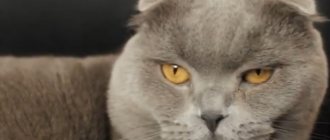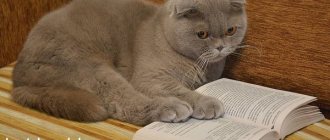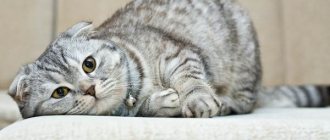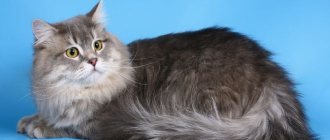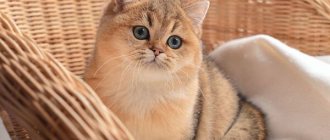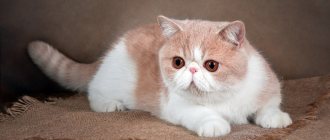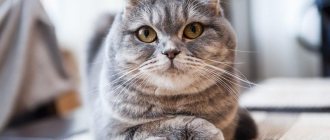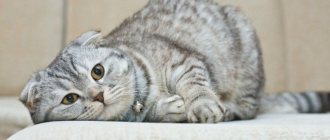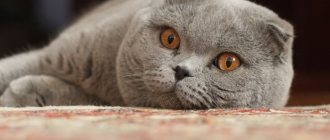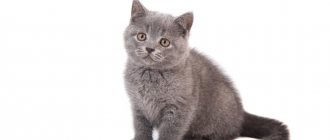A fluffy little ball with a cute face and a calm character, this is a Scottish Fold long-haired cat. The Highland Fold breed is not yet widespread in Russia, but is already gaining popularity. Many admire her luxurious appearance and high intelligence and want to have such a pet.
Let's find out what the characteristics of this breed are and whether the Scottish Fold beauty is easy to care for.
Brief history of the breed
The Highland Fold breed of fluffy cats appeared in the 70s of the last century. At that time, Scottish Folds were at the peak of popularity - short-haired Scots with flattened ears. Therefore, breeders decided to create a long-haired, fold-eared variety.
To obtain a new breed, British cats were crossed with Persian cats. It was they who passed on the luxurious fur coat as an inheritance to their descendants. The crossbred kittens were then bred to Scottish Folds.
As a result of artificial selection, incredibly beautiful semi-long-haired kittens with rounded faces and small ears pressed to the head were obtained.
The first fluffy-haired kitten was born in Scotland in 1961 to farmer William Russo. It was a girl named Susie.
The Highland Fold owes its name to the mountainous terrain where it was bred.
Colors
In addition to the silky structure of its thick and long coat, the Highland Fold has a stunningly wide palette of colors. Conventionally, they are divided into the following groups:
- Plain. All existing options are marble, black, chocolate, blue, lilac and red. The color is solid, without marks, spots or stripes.
- Smoky. In this case, the undercoat is colored entirely light, and the tips of the guard hairs are black.
- Bicolor. The Highland Fold of this color has a variety of combinations of strictly two colors in the form of spots and markings.
- Colorpoint. The breed standard allows for acromelanism in Highland Folds. In this case, the body is painted in a light color, and the protruding parts of the body: muzzle, legs, tail, and sometimes ears are dark.
- Tabby. In this case, the cat will look like a tiger or leopard, only in a more fluffy and touching version. Any combination of colors, the main thing is a clearly readable letter “M” on the forehead.
- Tortoiseshell. Basic colors are black and red in a bizarre combination.
- Calico. Considered one of the rare ones: the lower part of the Highland Fold's body is painted white, and the upper part has different shaped spots of black and red.
Interesting Facts
Highland Folds have not been able to gain the popularity of their short-haired cousins, but many agree that they are special. To be convinced of this, just study interesting facts about this breed of cats:
- Fold-eared longhairs become strongly attached to one of the family members. Such cats are usually bought for a child to instill in him a love for animals. Scottish Highland Folds love children and spend most of their time with them.
- In Europe, longhaired folds are used in the training program. They attend some lessons at school and also visit students at home.
- In the USA, Highland Fold cats also take part in raising and educating children. The kids read fairy tales to them, and the pets listen calmly. This helps children develop a love of books and improve their reading aloud skills.
- Scottish Fold Highland Folds have a weak vestibular system, so they never climb onto cabinets, shelves or hang on curtains. The cat feels anxious even when the owner simply lifts her off the floor to pick her up.
What is the price?
If the animal has the correct ears, has all the vaccinations, all the documents have been completed and the pedigree is in order, the cost of a long-haired Scottish Fold cat kitten will be 25 thousand rubles. You can buy it cheaper, but without a package of documents. In this case, the purchase will cost around six thousand rubles. This breed has been known in Russia for many years, so you can easily find nurseries that deal with them.
Breed description, standards, appearance
The Highland Fold breed was officially recognized only 20 years after the appearance of the first fluffy fold-eared cat. The following felinological organizations allow them to participate in exhibitions:
- TICA;
- CFA;
- CCA;
- WCF;
- CFA.
The description of the Highland Fold is in many ways similar to the standard Scottish Fold shorthair. Cats of these breeds have almost the same build, size, and color. The only difference is in the shape of the ears, the length and structure of the coat.
Dimensions and weight
Scottish Fold longhaired Highland Fold cats look quite large, as they have a knitted body and a thick coat. An adult cat weighs 6-8 kg, and a female cat weighs 4.5-6 kg. Height at the withers ranges from 28-32 cm.
Kittens are born weighing 75-125 g and rapidly gain weight up to three months. From the age of six months, growth slows down, and by two years it stops.
Anatomical characteristics
The Highland Fold cat breed standard provides for the following exterior characteristics:
- body with a well-developed muscle corset, wide back and chest;
- The head of the Fold Highland Fold is rounded;
- the eyes are large, expressive, widely set;
- The color of the iris in cats of this breed is golden yellow;
- The small ears of the Highland Fold are pressed tightly to the head and have rounded tips;
- the limbs are powerful, short, the paws are small, round in shape;
- the tail is quite thick, mobile, its length should exceed 2/3 of the length of the body.
Color and coat type
The Highland Fold has a semi-long coat with a thick undercoat. It feels soft and silky to the touch. The longest fibers are located in the neck and chest, as well as on the hind legs.
The color can be any, with the exception of lilac, chocolate and color point. Also, the standard does not allow the presence of white medallions with a solid color in Highland Fold cats.
The most common wool color options:
- black;
- smoky;
- tabby;
- tortoiseshell;
- bicolor
The rarest color of the Highland Fold breed is calico, or tricolor, when the lower part of the body is white, and there are black and red-brown spots of different sizes on the back and sides.
Castration and sterilization
After castration, the animal becomes calmer and more docile, paying more attention to household members. He cannot develop pathologies of the reproductive organs, because they are completely removed. In general, the health and quality of life of neutered animals improves.
The optimal age for castration is considered to be from 10 to 12 months. The operation itself is almost completely safe - complications were observed in only 0.05% of cases. It does not take much time - no more than 15 minutes. The pet can return home almost immediately after the procedure.
Post-operative care
After surgery, the animal is taken home in a carrier. You should stay nearby until your pet recovers from anesthesia. It is better to place it on the floor, on a mat
It is important to protect your pet from contact with children and other pets, and also to maintain silence
The owner should carefully monitor the condition of postoperative wounds. In the first two days they may be red and swollen - this should not be a concern. Soon the swelling will subside, and the wounds will heal completely in about 10–14 days.
During healing, it is necessary to lubricate the wounds with green paint and make sure that the animal does not lick them. For this purpose, veterinarians recommend wearing a special collar for your pet, called an Elizabethan collar. In the first days after surgery, you should temporarily stop using the litter tray - its granules can get into the wound and cause inflammation.
Character and temperament
The Highland Fold is a lively, active cat with a soft and pliable character. Scottish Longhairs need care and attention and should not be left alone for long periods of time. Fold-eared pets love to play with children of all ages. You don’t have to worry about the baby’s safety – these cats are not prone to display aggression. However, a child should not offend his furry friend.
The Highland Fold loves to be the center of attention. If guests come to the house, the cat will not hide, but will be among people and demonstrate its beauty and tenderness.
Although long-haired folds love affection, they do not sit on hands for a long time. For the most part, the Highland Fold prefers to lie in the arms of its owner and purr to itself. It is worth noting that they are not characterized by intrusiveness and excessive talkativeness.
Cats of this breed are smart, so they easily learn the rules of behavior in the house. It is important to accustom them to order from childhood, then there will be no problems with adults.
The Scottish Fold Highland Fold can live with a small dog if it is not prone to aggression. It is also possible to live together with a cat of another breed. The main condition for peaceful coexistence is showing love and attention to all pets.
Health
On average, representatives of this breed live 13-15 years and can boast of good health. There may be some genetic mutations, signs of which are already visible in infancy.
Cats of this breed, like their short-haired counterparts Scottish Folds, are bred with representatives of straight-eared Scottish cats (straight fold). If both parents are lop ears, various genetic abnormalities occur and the offspring are not viable.
The lop ear gene also determines the tendency of these cats to various problems with the musculoskeletal system. A predisposition to bone and joint diseases is indicated by:
- short tail, with curvatures, seals;
- protruding vertebrae of the skeleton;
- uneven, waddling or limping gait;
- lack of activity typical of kittens, isolation.
Otherwise, the Highland Fold is a fairly healthy breed. A cat may get cardiovascular diseases common to these animals, it may have kidney problems, tartar, and worms.
Most of them occur due to insufficient or improper care. The cat must be regularly taken to the veterinarian for a medical examination, vaccinated, given vitamin and mineral supplements, anthelmintic drugs, and treated with anti-tick and flea compounds. The pet needs to be fed properly and fully, its ears, teeth and eyes should be cleaned, and it should be regularly examined independently, then it will live a long and very happy life.
How to choose the right kitten
Buying a Highland Fold kitten is not so easy. The Scottish Longhaired Fold cat is not very common, so you will have to reserve your pet from a breeder in advance.
Animals are usually handed over to new owners when they reach three months of age. There is no need to rush when choosing a kitten. It is worth waiting until the baby's ears are formed. They begin to fall at the age of 2-3 weeks, then it becomes clear which of the litter is fold and which is straight.
Important! Before you buy a kitten, you need to make sure that it really belongs to the Highland Fold breed. The breeder must provide the new owner with a pedigree, as well as veterinary certificates of vaccination.
Before picking up a kitten from the nursery, you should examine it. A healthy Highland Fold is active and easy to contact. He has clear eyes and ears, as well as the area under his tail. The wool is soft, silky, neat.
Kitten care
Fluffy, fold-eared Highland Fold kittens do not require complex care. At the age of three months, when they are taken from the nursery, they are already vaccinated, trained to go to the litter box and know the scratching post. Babies sleep and play most of the time.
Caring for a small Highland Fold involves brushing the coat once a week, cleaning the eyes and ears. The owner of a Scottish Fold longhair cat must provide it with high-quality food.
Adaptation of a kitten in a new home
At the time of purchase, the kitten is three months old. His actions are conscious, so the house will initially be foreign to him. The owner must prepare for the baby's arrival:
- Buy a tray and feeding bowls.
- Let him sniff and get to know his new home.
- First, show him the toilet and the place where he will eat.
Although Fold Highlands are rare, once they appear, they forever take the love of their owners. This special breed is easy to care for, does not require elite food, gets along with children of any age and loves to lie on adults' laps. With proper care, a beloved pet will please its owners for about 20 years.
Did you like the article?
Care and maintenance
The Highland Fold can be kept both in a small apartment and in a private house. These calm cats can do without walking. But if you have your own fenced yard, it is not prohibited to let your lop-eared pet outside in the warm season. But it’s still better to walk on a harness and accompanied by the owner.
Hygiene procedures
Caring for a Highland Fold is easy, but there are some nuances:
- The Scottish cat's ears are downward, so the pet cannot clean them on its own. The owner of a fold-eared cat will have to inspect the sinks every 7 days and, if necessary, remove excess wax. This is done using a cotton pad soaked in a special lotion.
- It is recommended to wipe the Highland Fold's eyes daily, as tear tracks form under them, and brownish crusts remain in the corners.
- Caring for your Scottish Longhair also includes shortening the nails. This is done once every 2 weeks using a nail clipper. It is very important to cut only the tip of the claw, about 1 mm long, so as not to touch living tissue.
- The Highland Fold's teeth are brushed with a special paste for animals once a week. Dental treats are used for daily oral care.
Grooming
Long-haired cats need regular brushing. The procedure is carried out every 3 days, and during molting - daily. Although the Highland Fold's coat does not usually mat, you should not neglect its care. Otherwise, when licking, the cat will swallow hair, and this is very dangerous for health.
Scottish Folds do not really like to bathe, so they are rarely washed - if the pet is dirty or before a show. It is better to use shampoo and conditioner for long-haired cats. The Highland Fold has an airy and thick coat that is difficult to wet. You will have to water your pet with a ladle until all the fur is wet.
To wash off the shampoo, you need to change the water in the basin several times, or you can use the shower if the cat is not afraid of it. After bathing, the wool takes a long time to dry, so it is thoroughly dried with a terry towel. To prevent your cat from catching a cold, you need to place it in a warm, draft-free place until it dries out.
Tray
Highland Fold cats quickly remember where the tray is and what it is for. It is important to keep it clean, since Scottish cats are very clean and do not like to go into dirty litter. It is advisable to remove lumps and excrement in the morning and evening. Once a week, it is recommended to completely empty the contents of the tray and wash it with hot water.
Wool is the pride of the breed
Due to their close relationship with the Scottish, longhaired Scottish cats closely mimic the appearance of their less furry relatives. The only difference between the breeds is the length and quality of the coat.
Highland Straights got their fur from the Persians, which automatically deserves admiration, because Persian wool takes pride of place in popularity among cat fur coats.
In addition to its elegant appearance, wool has many other advantages:
- The fur does not have the habit of getting into tangles, so owners do not have to comb the cats too often;
- Another plus is cleanliness. The coat is long, but the cat is easy to care for, so you won’t have to bathe your pet often;
- The molt is going more or less tolerably. A cat sheds less hair than a Persian. And with regular brushing, its amount can be reduced to a minimum.
Crossbreeding experiments gave the breed a whole range of different colors and shades. There are several popular colors: black, white, tabby, merle, harlequin, two-tone and smoke.
Feeding the cat
Proper nutrition is the key to the health of the Highland Fold. Cats of this breed can be fed both dry industrial formulas and natural food. True, in the second case, the owner will have to independently think through the diet and compose it so that the pet receives all the necessary nutrients.
Complete diet
When feeding natural food, 80% of the total food volume is lean meat:
- rabbit meat;
- poultry fillet;
- beef;
- veal.
Up to two times a week you can give your Highland Fold offal - stomachs, heart. Liver is offered less often, as it has a laxative effect. In addition to meat, the Scottish Longhair cat’s diet includes:
- porridge with water without adding salt;
- vegetables – broccoli, spinach, carrots;
- fermented milk products – yogurt, classic yogurt;
- quail or chicken eggs;
- low-fat cottage cheese.
It is prohibited to feed Highland Fold cats pork, beans, potatoes, fried, salty, spicy foods, as well as sweets and baked goods. You cannot give canned food for people, as well as mushrooms in any form.
Veterinarians recommend feeding the long-haired fold-eared Highland Fold with premium or super-premium industrial mixtures. If your pet eats dry food, he needs to drink a lot of water.
Feeding frequency
An adult Highland Fold cat should be fed morning and evening. Kittens have a faster metabolism, so they eat more often. After three to four months, the pet is transferred to four meals a day, and after six months - to three meals a day. Until this time, Scottish Folds are under the care of a breeder in a nursery, who feeds them 5-6 times a day.
Vitamins and minerals
If a cat eats natural food, there is a risk that it does not receive enough vitamins and minerals. In this case, her immunity decreases and her coat loses its shine. For this reason, it is advisable to feed the Highland Fold with vitamin and mineral complexes twice a year - in spring and autumn.
Diet of Scottish straight cats
Scottish Straight cats, like other purebred cats, can be fed with both specialized food and natural food. You should not mix feeding methods, nor should you mix different types of dry food.
Adult cats are fed twice a day. The serving volume is calculated depending on the size of the cat. A healthy cat's diet should be based on lean meats such as beef and chicken. The meat can be boiled a little or given raw.
Cats do not digest milk, so giving it is pointless. For nutritional value and as a vitamin supplement, you can cook porridge from rice, buckwheat, millet, to which pieces of meat or fish are added.
Scottish Straights need a lot of vitamins, which they can get from fresh greens. In the summer, it is enough to walk your pet so that it eats green grass, and in the cold season you can grow greens, which are sold in pet stores. The herb promotes the absorption of food and its digestion.
Interesting fact: Some cats really love bread - you can give it, but not overuse it. Scottish Straights should not be given anything salty, fried, smoked or sweet, as well as foods that are generously sprinkled with spices. Potatoes, mayonnaise and any canned food are also prohibited for Scottish Straights.
If you choose to feed with special ready-made mixtures, then you should opt for premium food. They maintain a balance of minerals, vitamins and useful things that an adult animal needs.
Education and physical activity
Long-haired cats of the Scottish breed are moderately active. Highland Folds love to play with toys - balls, ropes, interactive mice. It is not at all necessary to install a cat complex in the house, since the pet is unlikely to climb up due to its fear of heights.
High intelligence is something that cannot be taken away from a fold-eared long-haired cat. She is easy to train and can even be taught simple tricks. In order for the Highland Fold to remember commands, you need to show patience and love, but under no circumstances should you yell at him or treat him roughly.
It is better to use the reward method - praise for success and give a treat.
Real reviews from owners
Reviews from Highland Fold owners are almost unanimous: there is no better breed in the world. The extraordinary intelligence, neatness, intelligence and charm of pets are noted. Looking at photos of Highland Folds of various colors, it is impossible to remain indifferent. By giving your care to a small Highland cat, the owner will receive in return the sincere affection of an independent Scottish Fold cat.
Ksenia: “Our Tom is already 4 years old. The smoky gray cat with amber eyes and unique floppy ears is a real family favorite. Clever and neat, you'll find the kind to look for."
Maria: “The best breed: calm, balanced, unobtrusive. My Lesya is always next to me, accompanies me in all matters. She is so delicate and charming that you are simply amazed.”
Health and susceptibility to disease
Representatives of the Highland Fold cat breed have strong immunity, but they still have a predisposition to certain diseases:
- Osteochondrodysplasia. The disease manifests itself as lameness, slow growth and deformation of the limbs. She is incurable. The veterinarian can only prescribe maintenance therapy.
- Urolithiasis disease. It occurs more often in cats. Typical manifestations are difficulty urinating, the presence of blood in the urine. The prognosis for recovery is favorable if treatment is started on time.
- Obesity. Like all Scottish cats, long-haired Highland Folds love to eat, so they often gain excess weight. When feeding, it is important not to exceed the manufacturer's recommended daily dose of food.
Proper nutrition
To maintain a healthy condition and for the activity of a cat, it is necessary to feed it well.
There are the following ways to feed Highland Folds:
- natural, including products such as yoghurt, fermented baked milk, low-fat cottage cheese, boiled poultry, boiled sea fish;
- dry and wet food, which must be consumed with fresh water;
- mixed feeding, consisting of both natural products and dry food plus fresh water.
By the way, with a mixed diet, you cannot mix both types of food in a bowl. Each type of food should be served in a separate plate.
Small folds (up to 4 months) are fed 4 times a day, then the kitten is transferred to a three-time meal plan, and starting from 8 months, the Scottish Fold eats 2 times a day. The main thing is not to overfeed your pet, because excess weight will negatively affect the well-being of the fold.
Vaccinations and antiparasitic treatment
Highland Folds are not immune to contracting deadly infectious diseases. Scottish Fold cats must be vaccinated annually:
- from rabies;
- calcivirosis;
- panleukopenia;
- chlamydia.
The first vaccination at the age of 12 weeks is carried out in the nursery. It is important to make sure that the kitten has been vaccinated against all of the diseases listed. The breeder must give the new owner a veterinary passport, which contains information about vaccination.
Even if the Scottish Fold cat does not go outside, it is necessary to periodically treat fleas using drops on the withers. It is recommended to worm your Highland Fold twice a year.
Highland fold mating
When thinking about breeding Highland Folds, you should know that only following certain mating rules will help you get healthy offspring with excellent breed characteristics. The first and most important of them is that you cannot cross two lop-eared partners. The offspring of such parents will appear with serious pathologies. The ideal partners for highland folds are the “Scots” straights.
The second important point is that you should not breed a female if she is not yet one and a half years old. It is at this age that the cat is ready to bear kittens and give birth. Ideally, the first mating should occur during the pet’s third estrus.
The cat is brought for a “date” to the cat, usually on the second day of estrus. Both partners must be treated for parasites and vaccinated in advance. It is better to select an experienced male, especially if this is the female’s first mating. It is desirable that the cat be larger than the female cat, as well as the same or similar color. For a guaranteed result, the female must stay with the male for at least two days.
Pros and cons of the breed
Getting to know the Scottish Highland Fold cat breed will not be complete without studying their advantages and disadvantages:
| pros | Minuses |
| Attractive appearance | Genetic predisposition to certain diseases |
| Friendly character | Low prevalence of the breed |
| Strong attachment to the owner | The need for regular brushing |
| Get along with other animals | Overpriced kittens |
| High intelligence | |
| Lack of aggression, tolerance towards children | |
| Good adaptive qualities | |
| Stress resistance |
The Highland Fold cat breed is an ideal choice for a family with children. Such a pet will become a child’s best friend and will delight its owners every day.
Nutrition
The beauty of Highland Folds directly depends on their diet. In order for a cat’s coat to be silky and neat, the animal must eat a balanced diet, consuming a sufficient number of vitamins and microelements.
If you feed your pet high-quality industrial food, then everything the cat needs will be included in this food. As a rule, food is selected based on the age of the cat.
Highland Fold kittens are fed 4 times a day, while adults are fed 2 times a day.
There should always be a container of water near the food bowl.
Especially if the animal eats dry food, it is important to ensure that there is plenty of water available to the cat.
Many Highland Fold owners prefer feeding their pet natural products. In this case, the animal’s food should consist of the following products:
- Meat (veal, chicken, beef).
- By-products (liver, lungs, hearts).
- Porridge (buckwheat, rice, oatmeal).
- Fermented milk products (cottage cheese, kefir). It is not recommended to give sour cream to Highland Folds.
- Boiled vegetables (white cabbage, carrots, beets).
It is worth seasoning boiled food for your pet with vegetable oils in small quantities. Oils promote good absorption of beneficial microelements and vitamins.
You can also feed your cat greens: parsley, dill, lettuce, spinach, arugula, sprouted wheat.
It is important to avoid your cat eating leftovers from the owner’s table, flour, fried and dried food. Spices and sugar should not be added to animal food.
As a treat, you can feed your Fold apples and biscuits in small quantities.
